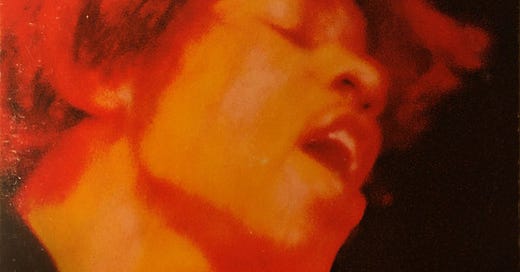Might even raise a little sand
The Jimi Hendrix Experience - 'Voodoo Child (Slight Return)' (Electric Ladyland - 1968)
While the cult classic Withnail and I doesn’t have too much plot getting in the way of the film’s endlessly quotable dialogue, there is a point where ‘Marwood’ awakes in the back of the car to find Withnail thundering towards London at breakneck speed despite not having a driving license and having the alcohol content of one of those foam mats that sit under beer taps, while this is happening we get a second song from The Jimi Hendrix Experience, ‘All Along The Watchtower’ is used as they leave the capital and ‘Voodoo Child (Slight Return)1’ heralds their, well return.
This is a very astute combination of music and film, Withnail and I is a film that explores what happened when the dream of the 1960s started to turn sour and die2 and ‘Voodoo Child (Slight Return)’ ended up being a symbolic tribute to one of the decade’s leading lights as his flame flickered out a few short months into the next decade and it ended up topping the UK singles chart weeks after Jimi Hendrix had died.
The song developed from a jam recorded in May 1968, which itself would go on to be ‘Voodoo Chile’ and featured Steve Winwood of The Spencer Davis Group, Traffic, and Blind Faith. The following day ABC television were in the studio and filmed what was going on. Noel Redding explained, "We learned that song in the studio ... They had the cameras rolling on us as we played it", Hendrix added;
Someone was filming when we started doing [Voodoo Child]. We did that about three times because they wanted to film us in the studio, to make us—'Make it look like you're recording, boys'—one of them scenes, you know, so, 'OK, let's play this in E, a-one, a-two, a-three', and then we went into 'Voodoo Child'.
Music writer Charles Shaar Murray looked into Hendrix's use of the term "Voodoo Child" in his book Crosstown Traffic:
Voodoo symbolism and reference resound through the country blues, and through the urbanized electric country blues of the Chicago school ... In Hendrix's case, this is pure metaphor. He certainly was not a Voodoo initiate in any formal sense ... Both with 'Voodoo Chile'—and, most specifically, with the West African even-before-Bo-Diddley beat he percussively scratches from his guitar and wah-wah pedal at the beginning of 'Voodoo Chile (Slight Return)' [sic]—he is announcing as explicitly as possible that he is a man of the blues, and one who honours, respects and understands its deepest and most profound traditions".
I think it would be fair to say that given how deeply embedded psychedelic and hallucinogenics had become in the counter culture by 1967, some elements of voodoo, with shamans, spirituality and “medicines” would have been interesting to someone like Hendrix. Hendrix himself, in his vocal, sings about chopping down mountains and sounds like he holds magical powers to create and destroy. Hendrix also has an obvious Caribbean and West African connection with his African American (and Irish) ancestry.
The track’s most important legacy, though, is, of course, the guitar work. Had there ever been a better use of a wah-wah pedal? It builds from a simple riff into something that sounds like a supernova exploding within too long. It also features one of those tricks producers enjoyed at this time: using stereo-panning to move the solo from one channel to the other. The solo is loud, booming, experimental and abrasive while technically impressive, cinematic and cosmic.
We get feedback and more pedals, then backwards feedback, whammy bar and distortion. It is the best synthesis of the type of blues that Hendrix would gravitate to in his post-Experience recordings and like being strapped to a rocket and held there by dazzling hard psychedelic rock that was clearly out of this world. It is one of the best rock tracks of the era and would also open up genres such as funk-rock and influence previous denizens of The Run Out Grooves such as Prince and Stevie Wonder.
After three albums of some of the most virtuoso guitar-playing the world had ever heard, it was only appropriate that The Jimi Hendrix Experience went out with one last visit to the stratosphere.
For the avoidance of doubt and straight from Wikipedia;
Jimi Hendrix occasionally used different names and spellings for some of his songs. In his handwritten lyrics, he used "Voodoo Chile" for the longest song, while he used both "Voodoo Chile (Slight Return)" and "Voodoo Child (Slight Return)" for the following one recorded with the Experience. In his handwritten album notes for Electric Ladyland sent to his record company, he listed the songs as "Voodoo Chile" and "Voodoo Child (Slight Return)"; when the album was released in the US by Reprise Records on October 16, 1968,these spellings for the two songs were used. When Track Records subsequently released the album in the UK, the songs were listed as "Voodoo Chile" and "Voodoo Chile (Slight Return)". In 1970, the "(Slight Return)" song was released as a single in the UK and it was simply titled "Voodoo Chile", without the further designation. Later album reissues usually follow the Reprise or Track album spellings, depending on the country of origin.
Glad that is settled.
As Danny memorably puts it “They’re selling hippie wigs in Woolworths, man. The greatest decade in the history of mankind is over.”




